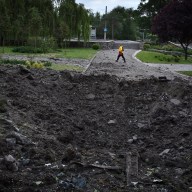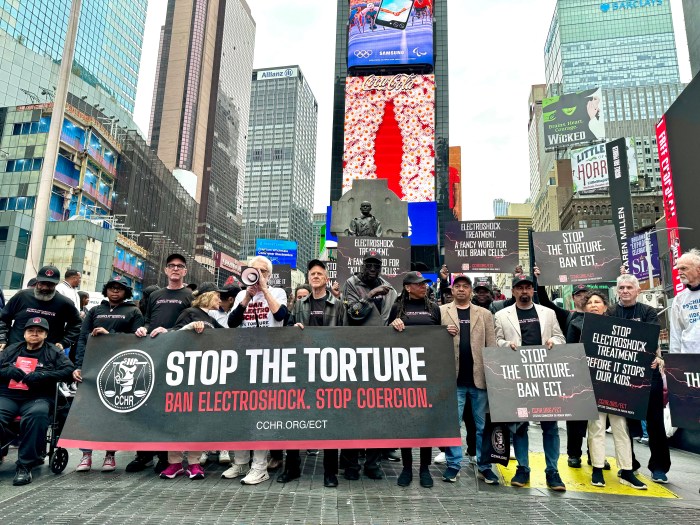WEST VANCOUVER, B.C. – A police chief’s detailed explanation of the threat RCMP officers faced when confronted with a violent, armed 11-year-old boy has done nothing to satisfy critics of police use of Tasers.
The West Vancouver Police Department was tasked with doing an outside report into RCMP actions last April when officers used a Taser to subdue the boy after a stabbing at a Prince George, B.C. group home.
Chief Pete Lepine issued a statement Monday detailing the events that day as part of an explanation of why his force concluded the RCMP officers did nothing wrong.
But David Eby, executive director of the B.C. Civil Liberties Association, rejected the report as insufficient. Lepine said in his statement his force consulted with the association before releasing their report.
Eby said rather than justifying the use of the Taser on the child, Lepine’s report has “elevated the seriousness” of the case.
“On the surface it seems like there’s some pretty serious issues that have been glossed over,” he said in an interview.
He said an external review by the Commission for Public Complaints Against the RCMP, already underway, is the only one he’ll put any stock in.
Rob Gordon, director of the school of criminology at Simon Fraser University, praised Lepine for taking steps to be transparent.
But he said the real question is what would officers have done before Tasers came along: Would they have shot the child?
“You can be right by policy, which then excuses the police officer from any consequence for his or her actions. But if the policy is defective in some way, that is no compensation,” he said in an interview.
Lepine said in a news release Monday the RCMP officers involved that day faced a dire situation that had little chance of a publicly acceptable outcome.
Police were convinced the boy was violent and a danger to himself and others when they used a Taser on him following a confrontation.
Lepine wrote officers could have declined to use a Taser and risk the situation escalating to the point where the boy harmed himself or others, possibly forcing officers to use lethal force.
Or officers could take the path they ultimately chose: Use the Taser on the boy and deal with the public relations disaster later.
“I can assure all of you that everyone involved in the original incident, as well as the investigation, was fully aware and sensitive to the fact that the police were dealing with a child,” Lepine wrote.
“However, ultimately, the boy’s age was secondary to the fact that his apprehension was deemed necessary in order to prevent him from causing further grievous bodily harm or death.
“…If the officers had decided not to take overt action to apprehend the child quickly, they would likely have been subjected to harsh criticism for standing idly by while the child harmed himself or someone else.”
Lepine was heavily criticized last month for releasing his investigators’ independent findings into RCMP actions that day by simply saying the officers were justified in using the device on a child.
He provided no explanation as to why then.
The report released by Lepine on Monday appears intended to satisfy those questions.
Police were called to the Prince George residential group home at about 5:30 p.m. after a report that an adult had been stabbed by an 11-year-old boy.
Officers were told the boy was hearing impaired but that his hearing aids had been damaged in a previous incident.
Before police arrived at the scene, the boy had holed himself up at the large residence with a bottle of wine and a knife. He also had access to other weapons, Lepine’s report said.
Police were told he was “prone to extremely violent outbursts, during which he exhibited extraordinary strength for his age and size and presented a viable threat to his own safety as well as the safety of adults attempting to manage his outburst,” the report said.
Investigators were also told he would not back down from a physical confrontation and could attack officers.
The police who arrived on the scene positioned themselves to watch the boy and quickly determined that a forced entry of the residence wasn’t reasonable.
Instead, officers attempted to negotiate with him.
Lepine’s report said when the boy appeared at a small second-story window, one of the officers tried to talk to him. The boy opened the window and used a knife to cut out the screen and hung his upper body outside, prompting concern he might fall.
Discussions stopped.
Lepine’s report said officers also saw the boy slashing at his sweatshirt and running a knife blade over the palm of his hand and up his arms.
Eventually, the boy asked for some belongings, the report said.
Police left them on the front porch and the boy came to retrieve them — armed with a knife at all times. He made the sign of a cross, which police had been told was “an indication that things were going to get bad.”
The boy came out of the house again to post a note, which officers couldn’t read.
At this point, Lepine’s report said, investigators concluded that their efforts to de-escalate the situation weren’t working and that the boy was increasingly a danger to himself.
“His willingness to engage in violence and use weapons against adults indicated that physical confrontation with the boy would present an extremely high risk to all involved,” the report said.
The officers decided to use a Taser if the boy appeared again.
The boy was asked to come out and clarify the contents of the note. When he did, he was holding a knife and a Taser was deployed once.
Officers gained physical control of the boy. They found he had a pen, not a knife, in his hand.
During the independent investigation of the RCMP’s actions, Lepine said West Vancouver investigators sought the opinion of a “recognized subject matter expert” in policing that concluded the officers’ decisions were “sound, appropriate to the situation and in keeping with their training and existing policy.”
“It was clear to me that the officers involved responded to a dynamic and potentially deadly incident in a measured, appropriate and professional manner,” Lepine concluded.
After the boy received the jolt, he was taken to hospital for observation and released the next day.
Two RCMP officers were placed on administrative leave after the incident, but they returned to their full duties in late June.
The RCMP is also conducting its own, internal review of the incident. The Commission for Public Complaints Against the RCMP and B.C.’s children’s watchdog have also launched investigations.
Mary Ellen Turpel-Lafond, the province’s children’s representative, is examining group homes altogether, saying the Tasering incident justifies a special report of its own. She said she has had concerns for more than three years that have never received a satisfactory response.
















